
Basque
Region (Pais Vasco/Euskadi) - Alava / Argómaniz  |
|

| Álava is a province
of northern Spain in the southern part of the Basque Autonomous Community.
The province numbers a population of 301,926 inhabitants (2006 official
estimate) in an area of 2,963 km².
It is bordered by the provinces of
Burgos, La Rioja, Navarre, Guipúzcoa, and Biscay. The Condado de
Treviño is an enclave of province Burgos (Castile and León)
surrounded by Alavese land, although strong population support advocates
Treviño's attachment to the Basque Autonomous Community.
The vast majority of the population
clusters in the capital city of Álava Vitoria-Gasteiz (Vitoria is
the Spanish name, Gasteiz the Basque name), which also serves as the capital
of the autonomous community. The remainder of the territory is largely
countryside and crops dotted with sparse population nuclei distributed
into seven counties (cuadrillas): Añana; Ayala; Campezo; Laguardia;
Salvatierra; Vitoria-Gasteiz; Zuya. It also contains the municipality of
Berganzo. |

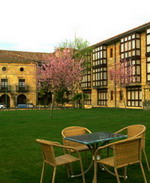 |
Parador
de Argómaniz, Alava - Argómaniz
The hotel occupies a magnificent
renaissance palace overlooking the natural beauty of the Alavese plains,
the Gorbea mountains and the marsh of Ullibarri Gamboa. The area invites
walks through the nearby village of Argómaniz and is an ideal location
for enjoying the beautiful surrounding nature reserves. The palace,
where Napoleon’s forces rested before attacking the city of Vitoria, has
the Larrea family coat of arms on its façade. The rooms, floors,
furniture, chests and other features in the hotel benefit from the charm
of the wood and the magnificent materials employed. These can also be seen
in its unique dining hall. The restaurant offers traditional cuisine, including
dishes such as los perretxikos (mushrooms), snails and goxua (custard,
cream and caramel sponge). |

Basque
Region (Pais Vasco/Euskadi) - Hondarribia - Guipúzcoa  |
|

| Hondarribia ("sand ford"
in Basque, also known by its Spanish name Fuenterrabía or the French
one, Fontarabie) is a town situated on the west shore of Bidasoa river's
mouth, in Guipúzcoa, Basque Country, Spain. The border town is sited
on a little promontory facing Hendaye (France) over the Txingudi bay. The
town holds an ancient old quarter with walls and a castle. In addition,
Hondarribia features a beach across the Bidasoa from the touristy housing
estate Sokoburu in Hendaye, alongside a mountain called Jaizkibel providing
a hilly backdrop to the town. A road leads north-east from the beach area
to the Cape Higuer, located in this municipality. The town harbours the
San Sebastian Airport, which serves domestic flights. |

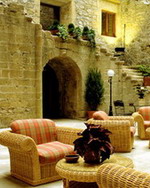 |
Parador
de Hondarribia, Hondarribia, Guipúzcoa
The hotel occupies a beautiful
castle built by the king of Navarre, Sancho Abarca, in the 10th century.
The building still retains the appearance and atmosphere of an original
medieval fortress and provides a magnificent backdrop to the costal location.
The thick-walled exterior of the fortress belies its beautifully renovated
interior. Do not miss the immense, natural beauty of the stonework
in the courtyard or the stunning sea views from the terrace and some of
the bedrooms, along the French coast. Allow yourself to be drawn into the
beautiful atmosphere of the castle as you explore its hidden nooks and
crannies, wandering through its arches and admiring the wrought-iron work
and coffering that adorn the walls and ceilings. Spears, cannons, and suits
of armour bring an air of elegance to the comfortable surroundings. The
Parador does not have a restaurant, however there are excellent places
to eat locally (ask in the Parador). A buffet breakfast is included in
the price of the room for guests staying at the Parador. |


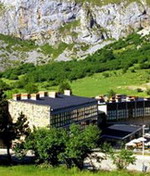 |
Parador
de Fuente Dé
This modern mountain refuge
located on the foothills of the Picos de Europa and opening onto the fertile
Liébana valley, shows nature in total freedom. It is surrounded
by the dramatic slopes of the Picos de Europa, woods and hillsides, in
a region which is split into modest hamlets. The building is located at
the bottom of the cable car which goes up to the Áliva viewpoint,
at a privileged meeting point for lovers of outdoor activities. The classical
mountain style and the warm wood and leather furniture recreate the much-appreciated
home warmth... |

Cantabria
- Limpias |
|

| Limpias is a municipality
located in the autonomous community of Cantabria, Spain. According to the
2007 census, the city has a population of 1.497 inhabitants. |

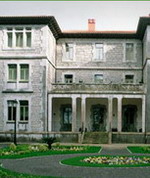 |
Parador
de Limpias (Cantabria)
The new Parador in Limpias
is located in the Palace of Eguilior estate, which was the summer headquarters
of King Alfonso XIII's Council. The palace belonged to Don Manuel de Eguilior,
the Count of Albox, and is attributed to the architect Emilio de la Torriente.
Rooms are large in size, decorated in a classical way, not forgetting any
details of modern facilities. Restaurant is well decorated in a classical
style. Dishes such as marmita de bonito (stew made with bonito tuna)
cocido montanes (traditional white bean and pork sausage stew), other white
and red bean stews, plus a variety of cheeses, and sweets such as the famous
Corbatas de Unquera, sobaos pasiegos, or Pantortillas de Reinosa are just
a few of the delights diners will enjoy. The palace is a large square
building with four pseudo-towers at each corner, none of which is very
high. |

| Cantabria
- Santillana del Mar |
|

| Santillana del Mar is a historic
town situated in Cantabria, Spain. Certain features of this historical
town includes Altamira Caves (Cuevas de Altamira) and many historic buildings,
attracting thousands of holiday-makers every year. There is an old
saying that Santillana del Mar is The Town of Three Lies, since it is neither
a Saint (Santo), nor flat (llana) and has no sea (Mar) as implied by the
town's name. However, the name actually derives from Santa Juliana (or
Santa Illana) whose remains are in the kept in the Colegiata, a Romanesque
church and former Benedictine monastery. |

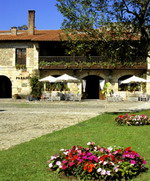 |
Parador
de Santillana, Santillana del Mar
This newly built manor house
conserves the typical architecture of the area, blending in perfectly with
the architectural surroundings of this beautiful locale. Comfortable rooms
with a pleasant atmosphere help the guest to find peacefulness and rest.
The restaurant and bar, located in the Parador Santillana Gil Blas offer
guests the opportunity to sample Cantabrian cuisine's most traditional
dishes. We recommend you try cocido montañes (mountain stew): cabbage,
beans, ribs, sausage, panceta, chorizo, black pudding all go into it. Enjoy
too the grilled beef steak with Tresviso sauce, the hake in Cantabrian
sauce, clams from Pedreña, the anchovy salad, the Cantabrian ventrisca
(tuna) and quesada pasiega (cheesecake). |

| Cantabria
- Santillana Gil Blas |
|

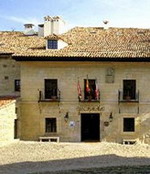 |
Parador
de Santillana Gil Blas, Santillana del Mar
The Hotel is in the lovely
mansion of the Barreda-Bracho family, in the square of Santillana del Mar,
a town declared a National Monument, whose origins go back to the 7th century.
The grand entrance leads to open, welcoming public spaces, with wooden
floors and traditional decoration and furniture. The bedrooms are
comfortable and in harmony with the overall look of the hotel. The dining
room serves traditional stews, steaks, hake from the Cantabrian sea over
green asparagus and quesada pasiega (cheesecake). The Emperador room
is the most emblematic at the Parador and, for this reason, has hosted
many famous figures such as General de Gaulle, the present emperors of
Japan, etc. |
Top
|

